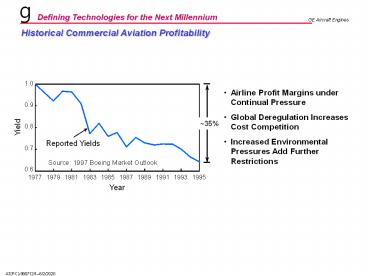Low Cost of Ownership Goal PowerPoint PPT Presentation
Title: Low Cost of Ownership Goal
1
(No Transcript)
2
- Airline Profits Fall Below Level Needed to
Finance Replacement - Engine Ownership Cost Reduction Can Maintain
Business Vitality
Potential Profit with 50Lower Engine Cost of
Ownership
Required Profit toAdequately Finance New
Equipment(Source The Economist)
Profit
Actual Profit(Source Walsh Aviation 3-2-97)
86
88
90
92
94
96
98
Year
Low Cost of Ownership Goal
3
2000 NM Mission - 50 Cents / Gallon Fuel
Aircraft System
Airframe Interest 19.9
- Goal 50 Reduction in Engine Cost of Ownership
Airframe Depreciation 23.3
Flight Crew 11.8
Fuel 12.9
Cabin Crew 6.2
22.4
AF Maint. 5.2
Engine Controlled Costs
Engine Interest 5.5
Insurance 2.2
Land Fee 2.9
Engine Depreciation 6.4
Engine Maint. 4.1
Fuel Cost Influenced by Drag SFC and Weight
Influenced by Manufacture and Assembly Costs
Fuel 28.7
Manta. 18.3
Depreciation 28.5
Interest 24.5
Assumed Proportional to Cost
Engine Cost of Ownership Model
4
(No Transcript)
5
Goals and Payoffs - Propulsion System
GOALS
PAYOFFS
- Reduced Greenhouse Gas Emissions
- Reduced Cost of Travel
- Reduced Dependence on Fossil Fuels
- Conservation of Nonrenewable Energy
- Improved Air Quality around Airports
- Reduced Depletion of Ozone Layer
- Reduced Cost of Travel
- Improved Safety and Reliability
- Improved Airline Customer Solvency
- Improved Airport Throughput
- Reduced Greenhouse Gases
- Quieter Neighborhoods around Airports/Increased
Traffic Throughput - Improved Air Safety Ease of Travel and Improved
Airport Throughput
- 10 Reduction in Fuel Burn
- 50 Reduction in NOx, CO, and HC
- 50 Reduction in Ownership Costs
- 10 Reduction in CO2 Emissions
- 30 dB Reduction in Noise
- 50 Reduction in In-Flight Shutdownsand
Engine-related Delays andCancellations
Relative to 1999 State-of-the-Art Operational
Aircraft Relative to ICAO Requirements Re
lative to FAA Stage 3 Limits
6
(No Transcript)
7
(No Transcript)
8
Shaped Inlet - Predicted Noise Benefits on Fan
Tone Radiation
80 dB
Classic Inlet (-5 Droop)
75 dB
Advanced 3D Inlet (Scarfed)
65 dB
85 dB
50 dB
1-2 EPNL Benefit at Approach
9
Jet Noise Reduction - Chevron Nozzle
Discharge Velocity Profiles
Baseline Nozzle
Demonstrated 3.5 dBJet Noise Reduction Acoustic
Energy Reduced Greater than 50
Chevron Nozzle
10
Fan and Nacelle Noise Reduction Technologies
Scale Model Testing Validates Analysis Prior to
Full Engine Test
11
Low Stage Number Compressor
- Reduce Stages from 10 to 6
- - New Blade Design
- Lower Weight
- Improved Maintenance Capability
12
Twin-Annular, Pre-Swirl (TAPS) Combustor
3D Analysis
ACTS Rig
Advanced Diagnostics at CRD
Emission on Target to Meet Zurich Category 5
13
Turbine Aerodynamics
HPT Stage 1 Vane
- 3D Aerodynamic HPT Vane
- Convergent-Divergent HPT Blade
- Improved Performance
- 0.5 Fuel Burn
- 6-10C Benefit in EGT Margin
Conventional
3D Aero
14
Turbine Materials
- Higher Temperature Blade Material
- Improved Coatings
- Improved Disk Material
- Developing Better Materials for 4-to-1 Hot
Section Life Increase
15
Cycle and Configuration Comparisons with Current
Engine
16
(No Transcript)
17
A 10-year View of Technology
18
Summary
- GEAE Remains the Industry Leader in Aircraft
Engine Technology - Programs and Plans are in Place to Assure this
Status is Maintained in the Future - Strong Consideration is Given to Achieve Improved
Noise and Emission Signatures in a Manner
Beneficial to the Airlines and the Community
19
Defining Technologies for the Next Millennium
Dave Fancher August 12, 1999

